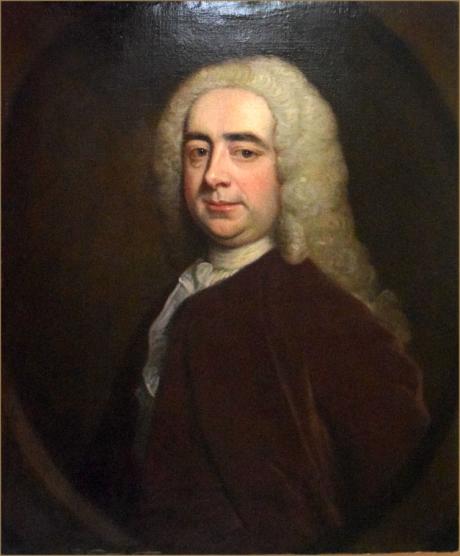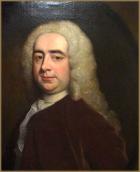Two handwritten labels on verso "Thomas Heath / Alderman of Exeter / Portrait of / Benjamin Heath / D.C.L. / B 1705 D 1759". "Thomas Heath / of Exeter / Alderman of Exeter / Portrait of / Benjamin Heath / D.C.L. / B 1705 D 1759"
Thomas heath was born in 1705 and died in 1759. He had a brother, Benjamin who became a merchant and fuller in Exeter. He married Elizabeth Kelland. They had 5 children. One was a Thomas again. He was mentioned in his father's will in 1725 when he, Thomas, was still a minor. However, his birth date seems to be unknown although he was baptised on 11th October 1729 at St Leonard's, Exeter. He was a merchant and then an Alderman. He became Sheriff in 1732 and then Mayor in 1738 and 1749. He died on the 5th and buried on the 12th July, 1759. Thomas Heath had three wives: Anne Philip Pyne, m.19th December 1730 but died 29th December 1736. Next was Anne Maria Pyne, m.1737 and buried in St Leonards on 16th February 1754. Finally, there was Ann Gandy who he married on 17th July 1753. She was buried at St Leonard's, Exeter on 9th April 1754.
Benjamin Heath, 1704-1766, critic and book-collector, born at Exeter on 20 April 1704, was eldest son of Benjamin Heath, fuller and merchant of Exeter (born at Exeter about 1672, and died 28 May 1728), who married Elizabeth Kelland (buried at St. Leonard's, Exeter, in October 1723). His parents were probably nonconformists, as he was not baptised in St. Leonard's Church until 11 Oct. 1729, when both of them had died. He was educated at the Exeter grammar school, and is said to have been admitted as a student of the Middle Temple in 1721, and again in 1729. The family records assert that he completed his education at the university of Oxford, but his name does not appear in the printed matriculation lists. On his father's death he inherited the handsome fortune of 30,000l., and about 1730 set out on the ‘grand tour.’ His travels took him to Geneva, where he married Rose Marie, daughter of Jean Michelet, a Genevese merchant, on 12 Aug. 1732, less than two months after she had passed the age of fourteen. In 1725 he had been sworn as a freeman of the Weavers' Company at Exeter, but his taste was not for business or a profession, and when he returned to England he abandoned his intention of being called to the bar, and settled in Exeter, where his chief pleasures lay in literature and book-collecting. Dibdin prints in the ‘Bibliomania’ (pp. 554-62) a long letter written by Heath from that city in 1738, with a lengthy list of books that he wished to buy. In 1740 he made his first appearance as an author with ‘An Essay towards a Demonstrative Proof of the Divine Existence, Unity, and Attributes,’ dedicated to William Oliver, a physician at Bath. It is said to have followed the lines laid down in the ‘Living Temple’ of John Howe, the puritan divine. He was elected on 23 March 1752 to the post of town clerk of Exeter, and held it until his death. All his life he studied the classical writers, and the fruit of his labours was shown in the volume of ‘Notæ, sive Lectiones ad Æschyli, Sophoclis, Euripidis quæ supersunt dramata deperditorumque relliquias,’ which was published at Oxford in 1762. On 31 March in the same year the university of Oxford conferred on him the degree of D.C.L. Parr, in a letter to Gilbert Wakefield (WAKEFIELD, Memoirs, ii. 439), speaks with indignation of the ‘arrogant and contemptuous’ terms applied to Heath by the German scholar Hermann in his ‘Observationes Criticæ’ (p. 59), and his note on verse 1002 of the ‘Hecuba.’ Heath's object was to restore the metre of the Greek tragedies. At home his observations were highly valued, and he was asked to furnish the notes for the Greek tragedies in use at Eton. The cider-producing districts were much agitated at the imposition of an excise duty on the producer of 4s. a hogshead by the ministry of Lord Bute in 1763. Popular meetings were held throughout Devonshire, Herefordshire, and Worcestershire, and violent attacks were made on the ministry. Heath took a prominent part in the controversy, and was the author of ‘The Case of the County of Devon with respect to the consequences of the new Excise Duty on Cyder and Perry’ (1763), to which many have ascribed the repeal of the act in 1766. The freeholders of Devonshire presented him with ‘a very large waiter and two pair of candlesticks’ in 1764 to mark their appreciation of his exertions. For some time he retained his interest in politics, and contemplated contesting the city of Exeter, but though he spent 1,000l. in preliminary expenses, he did not proceed to the poll. Heath issued anonymously in 1765 ‘A Revisal of Shakespear's Text, wherein the alterations introduced into it by the more modern Editors and Critics are particularly considered.’ He praises Theobald, and severely censures Warburton's conjectural emendations. His stock of critical appliances was scanty. He did not possess a copy of either of the folio editions of Shakespeare, nor had he seen Sir Thomas Hanmer's edition, but his natural acuteness ‘produced a number of very sensible annotations.’ His name appeared on the title-pages of two volumes of ‘Annotations illustrative of the Plays of Shakespeare, by Johnson, Steevens, Malone, Heath’ (1819), but very few of his critical observations are incorporated. Heath was ‘always a martyr to bad health, and led the life of a valetudinarian.’ He died at Exeter on 13 Sept. 1766, and was buried at St. Leonard's, Exeter, on 21 Sept. A copy of his full-length portrait by Robert Edge Pine, also by Pine, still hangs in the Guildhall. A mezzotint engraving of it was executed by J. Dixon, and has been introduced in ‘Heathiana’ (p. 8), and on p. 566 of Dibdin'‘Bibliomania.’ His wife, born 5 July 1718, survived until 19 Nov. 1808. Their family was seven sons and six daughters, of whom five sons and three daughters lived to middle age. His son Benjamin was head-master of Harrow 1771-1785, and a younger son, George, became head-master of Eton in 1796. A family group of Mrs. Heath and seven of her children was painted by R. E. Pine, and an autotype print, from a reduced facsimile in water-colours by G. P. Harding, faces p. 12 of ‘Heathiana.’ Mrs. Heath was naturalised by a special act of parliament about 1760.His great-grandson, Baron Robert Amadeus Heath, preserved the following manuscripts by him: 1. ‘Spicilegium Virgilianum, seu notæ ad Virgilii editiones Burmannianam et Martynianam.’ 2. ‘Euripides recensitus castigatus et illustrated supplementum editionum Kingianæ et Barnesianæ.’ 3. ‘Lectionum antiquarum pars prima, sive Lectiones Catullianæ ad editionem Cantabrigiensem.’ 4. ‘Lectiones Tibullianæ.’ 5. Supplement to new edition [by Seward] of Beaumont and Fletcher's works. John Forster, in a letter printed in ‘Heathiana’ (p. 11), says that Dyce had seen the last manuscript, and had adopted some, but not enough, of its suggested readings. In 1882 it was presented by Baron Heath to the British Museum and is now Addit. MS. 31910. In addition to these works Heath left behind him most of the materials for a new edition of Hesiod. He was a collector of rare books from the age of thirteen, and in his lifetime distributed his library between two of his sons, but still left a large collection. There was printed in 1810 a ‘Catalogue of Books containing all the rare, useful, and valuable Publications to the present time to be Sold in April and May by Mr. Jeffery, No. 11 Pall Mall,’ and the catalogue was reissued later in the year with the prices and names of the purchasers. Heath was the principal collector of this library, but it was augmented by his son, the Rev. Benjamin Heath.
Sources
Heathiana [by Sir W. R. Drake], privately printed, 1881 fol. and 1882 fol.; Nichols's Lit. Anecd. ii. 276-7, iv.
285; Halkett and Laing's Anonymous Lit. i. 319, iii. 2204; Dibdin's Bibl. Decameron, iii. 368; Oliver's Exeter, p.
216; Davidson's Bibl. Devon. p. 109; Watson's Warburton, pp. 337-8; Gent. Mag. 1764, p. 246.
Contributor
W. P. C.
PUBLISHED 1891
Thomas Hudson, (bap. 1701, d. 1779), portrait painter and art collector, was a native of Devon. He was probably the son of James Hudson (d. 1704) of Exeter, a victualler, and his wife, Anne, who was baptized George Hudson at the church of St Mary Major, Exeter, on 8 December 1701. According to George Vertue he was 'learnt of' the London artist Jonathan Richardson (Vertue, Note books, 3.66) and had married Richardson'sdaughter Mary (1700–1769) by 1725, when their first child, Ann Elizabeth (1725–1737), was baptized. Two other children, Mary (b. 1728) and Henry (b. 1729), died in infancy. Richardson made a portrait of Hudson, a drawing in red chalk (British Museum), at some time during the 1720s.
Until Richardson's retirement in 1740 Hudson painted portraits primarily in the west country, including Devon and Bath. His earliest portraits are documented in the accounts of the Courtenay family of Devon for 1728 (manuscript, priv. coll.). His early work imitates Richardson's in composition and technique. On Richardson's retirement Hudson gained a number of his master's clients and became more prominent in London. Described by Vertue in 1742 as 'a good ingenious man really of great merrit' (Vertue, Note books, 3.111), Hudson increased his patronage by hiring the Flemish artist Joseph van Aken as his drapery painter, a successful collaboration first mentioned by Vertue in 1743. His work soon showed the influence of portraits by Anthony Van Dyck.
During his career Hudson painted at least 400 portraits, about eighty of which were engraved. Sitters included members of the aristocracy, landed gentry, political leaders, Anglican clergy, and popular figures in music and the theatre. He was one of England's most employed portraitists in the 1740s and 1750s. Among his best-known portraits are Theodore Jacobsen (1746; Thomas Coram Foundation for Children, London), Lady Mary Andover (1746; Ranger's House, Blackheath, London), Benn's Club of Aldermen(1752; Goldsmiths' Company, London), Charles Spencer, Third Duke of Marlborough, and his Family (c.1755; Blenheim Palace, Oxfordshire), and two portraits of George Frideric Handel (1748–9; Staats- und Universitätsbibliothek, Hamburg; and 1756; NPG).
Some of Hudson's compositions may have been influenced by a trip in 1748 to France, Holland, and Flanders. By this time he had begun to form a collection of paintings, drawings, prints, and sculpture by other artists. His collection stamp, TH, is found on numerous old master drawings. Hudson continued to employ drapery painters after van Aken's death in 1749. A rapid trip to Rome in 1752 did not dramatically alter his work. Hudson's success attracted apprentices, among them Joshua Reynolds (1740–43), Joseph Wright of Derby (1751–3 and 1756–7), and John Hamilton Mortimer (1757). After the mid-1750s, when Reynolds began to receive commissions from Hudson'spatrons, a rivalry developed that has adversely coloured subsequent opinions of Hudson.
Although Hudson exhibited with the Society of Artists in 1761 and 1766 he was receiving fewer commissions by this time, and he retired to his villa in Twickenham. In 1770, after the death of his first wife, he married Mary Fynes (1702–1783). Hudson died at Twickenham on 26 January 1779. His will, dated 25 October 1776, names his second wife and members of the May and Carpenter families of Exeter among the legatees. Although Horace Walpole stated that 'the better taste introduced by Sir Joshua Reynolds put an end to Hudson's reign' (Walpole, 4.124) an unidentified writer in the St James's Chronicle, or, British Evening Post for 13 January 1781, wrote that 'Hudson was no bad Colourist, and was one of those Limners who gave an easy, if not a graceful, Attitude to the human Figure'. His collection was dispersed in 1779 and 1785, in three important sales.
- Ellen G. Miles DNB


